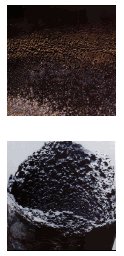Metal Corrosion
Corrosion is the natural tendency of metals to revert back to their ore form. Cast iron, for example, will form reddish-brown iron oxide (common rust) on engine surfaces (see photo). Likewise, other metals form oxides. The color of these various corrosion products can vary from white to black depending on the specific oxide that is formed.
A number of conditions in a cooling system will affect the degree and rate at which metal surfaces corrode. These include: coolant pH, the concentration of dissolved oxygen and carbon dioxide in a coolant, metal surface deposits, metal stress, coolant temperature, acids formed in the combustion
 process of the fuel, and the corrosion inhibitors present.
process of the fuel, and the corrosion inhibitors present.
Corrosion
All the metals in a cooling system will corrode under certain conditions. Some metals are more sensitive than others. Corrosion weakens metals, and the component will eventually fail. The metal most prone to corrosion in a cooling system environment is aluminum (see photo). Cast iron, solder, steel, copper, and brass will also corrode.
Coolant pH
One major factor on the corrosion rate of metals is the coolant’s pH. Shifts in coolant pH will affect the metals that corrode and the rate of each metal’s corrosion. The pH scale runs from 0 to 14. A coolant becomes more acidic closer to zero; and more alkaline toward 14. Coolant pH should always be maintained between 8.5 and 11. If a coolant’s pH drops below 8.5, it will become aggressive to ferrous metals (cast iron and steel), aluminum, copper and brass. If it increases above 11, it will
become aggressive to aluminum and solder in a cooling system. Maintaining optimum pH in a coolant is a critical function of a quality coolant additive (SCA). It is important to use coolant additive package containing a pH buffer to insure the optimum pH range of the coolant.
Critical components
A good corrosion inhibitor should contain the following critical components for proper corrosion protection: pH buffer This will help maintain optimum coolant pH (8.5 to 11). Borate, for example, is one of the best pH buffers available. It helps hold a coolant’s pH within the optimum range for providing corrosion protection for iron and steel components. Silicate: This is the best corrosion inhibitor for protecting aluminum metal surfaces. Nitrite provides the best protection available for cavitation/corrosion (liner pitting). Tolytriazole (TT) and mercaptobenzothiazole (MBT) These inhibitors provide protection for soft metals (lead, copper, brass). Nitrate provides aluminum and ferrous metals protection (iron and steel).
Modern Coolant Chemistries
The Maintenance Council (TMC) of the American Trucking Association has greatly simplified the task of caring for cooling systems. In 1996 TMC published a coolant specification known as RP-329, and a companion for Propylene Glycol based coolants, RP-330. These were the first specifications that defined “fully formulated” coolant technology. The coolants manufactured to this specification must be proven to protect both automotive and heavy-duty vehicles, without an initial charge of additive (SCA). The idea is simple, but the specification took years to develop. Another chemistry recently reintroduced into North America uses carboxylic acid inhibitor technology, more commonly known as an organic acid. Its high cost and poor availability relegate it to specific markets, and it should not be mixed with other American coolants. For more information about organic acid coolants vs. conventional coolants, click here.
Summary
A modern coolant that meets TMC RP-329 or RP-330 will provide excellent corrosion protection for any engine cooling system. This is the simplest solution to corrosion problems.
